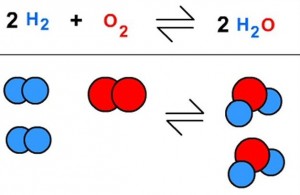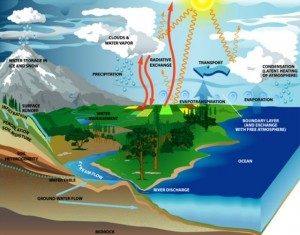Chemistry
Assuming that hydrogen gas behaves as an ideal gas, that conservation of mass (nothing is lost) is achieved, and that sufficient oxygen is available for complete combustion, 2 moles of hydrogen gas, when combined with 1 mole of oxygen (O2) will produce 2 moles of water. A mole of hydrogen gas weighs 2 grams and occupies 22.4 liters (volume) at standard temperature and pressure (1 atmosphere and 0 degrees C, or 760 torr and 273 Kelvin). Therefore, assuming complete combustion, 22.4 L of hydrogen gas weighing 2 grams would yield, upon condensation, approximately 18 grams of rather cold, pure water (the exact amount would vary according to the atmospheric pressure and temperature). In simple terms, 1 mole of water (18 grams) is 9 times heavier than 1 mole of hydrogen (2 grams).
The importance of these facts cannot be overstated, for they may well be the key to simultaneously halt –and perhaps eventually reverse- global warming, conquer drought, and introduce a new economic platform geared specifically to reduce the yawning gap in the distribution of income and wealth, all of which have been identified as clear and present threats to the security of the world by legions of prominent scientists and economists, the United States government, and the World Bank. Here’s why.
Hydrogen and Gravity
Elemental hydrogen does not occur naturally on Earth. Long ago it combined with other elements to form many compounds, including fossil fuels and water. The law of conservation of energy states that it takes more energy to free the hydrogen in the ocean than would be released by oxidizing it. As a result, the process is considered inefficient and uneconomical. But that law does not consider the possibility of using solar in combination with gravity –both of which are constant and free- to take advantage of the weight differential between water and hydrogen to recover the energy loss or, depending on a number of variables, generate a large surplus of electricity. In fact, even though the three raw materials (gravity, solar and seawater) are free, fully renewable, abundant and readily accessible, no nation is known to be presently considering utilizing them exclusively to produce hydrogen by electrolysis of seawater on a scale sufficiently large to generate all their electricity, or alternatively, export hydrogen to others that are either unable or unwilling to produce it. One reason is the misplaced belief that it is far more efficient, and therefore less costly, to use solar to generate electricity directly; another is the disproportionate effect that special interests have on electoral processes, and by extension, on elected decision makers.
The Water Cycle
The world’s true source of fresh water is the ocean; without it our planet would look like Mars. But, as with fossil fuels, surface fresh water is not uniformly distributed throughout the world. Some areas, such as the Great Lakes in the United States and the Amazon Basin have it in great abundance; others, including the great deserts of the world, have little to none.
Impending Threat
Global warming is exacerbating this uneven distribution, threatening the production of food in many regions of the world, including California –which produces more than ½ of the nation’s fruits and vegetables- and the Great Plains, where the Ogallala Aquifer is drying up. If this is not decisively addressed, the U.S., currently a major exporter, may eventually be forced to import much, if not most, of its food. That would increase its dependence on foreign suppliers, the trade deficit, and unemployment; by extension, it would also reduce the tax base and increase the federal deficit. More importantly, since other food-exporting nations may also experience similar problems, who exactly would have the spare capacity to fill the shortfall, and for how long? But there’s more. Natural population growth will create the need for new jobs and still more water. Clearly, humanity is at the edge of a precipice.
A Potential Game Changer
With the exception of desalination plants in some coastal areas, which consume enormous amounts of energy, humanity relies on the natural water cycle to quench its thirst and grow its food. The ancients did it thousands of years ago, and despite our technological advances, basically we’re still doing it the same way. The time has come to bypass the cycle, which no longer meets our needs. We must learn to manufacture our own fresh water far from coastal areas, where desalination is impossible or impractical, so we can irrigate the deserts, conquer drought, and spur economic growth regardless of climate change. Nuclear and fossil fuels cannot do that; hydrogen can. Plan A describes in broad detail a way to do so; therefore, given the glaring absence of other viable alternatives on a scale comparable to it, national governments and the United Nations should consider, at a minimum, assembling teams of prominent engineers, scientists and economists to confirm its feasibility. Time is of the essence.


